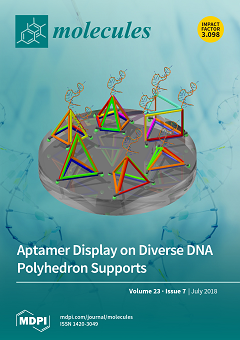Previously tested
n-hexane extracts of the
Scorzonera latifolia showed promising bioactivity in vivo. Because triterpenes could account for this activity,
n-hexane extracts were analyzed by HPLC to identify and quantify the triterpenes as the most abundant constituents. Other
Scorzonera and
Podospermum
[...] Read more.
Previously tested
n-hexane extracts of the
Scorzonera latifolia showed promising bioactivity in vivo. Because triterpenes could account for this activity,
n-hexane extracts were analyzed by HPLC to identify and quantify the triterpenes as the most abundant constituents. Other
Scorzonera and
Podospermum species, potentially containing triterpenic aglycones, were included in the study. An HPLC method for simultaneous determination of triterpene aglycones was therefore developed for analysis of
Podospermum and
Scorzonera species.
n-Hexane extracts of root and aerial parts of
S. latifolia, ten other
Scorzonera species and two
Podospermum species were studied to compare the content of triterpenes. HPLC was used for the qualitative and quantitative analysis of α-amyrin, lupeol, lupeol acetate, taraxasteryl acetate, 3-β-hydroxy-fern-7-en-6-one acetate, urs-12-en-11-one-3-acetyl, 3-β-hydroxy-fern-8-en-7-one acetate, and olean-12-en-11-one-3-acetyl. Limits of detection and quantification were determined for each compound. HPLC fingerprinting of
n-hexane extracts of
Podospermum and
Scorzonera species revealed relatively large amounts of triterpenes in a majority of investigated taxa. Lupeol, lupeol acetate, and taraxasteryl acetate were found in a majority of the species, except
S. acuminata. The presence of α-amyrin, 3β-hydroxy-fern-7-en-6-one-acetate, urs-12-en-11-one-3-acetyl, 3β-hydroxy-fern-8-en-7-one-acetate, and olean-12-en-11-one-3-acetyl was detected in varying amounts. The triterpene content could correlate with the analgesic and anti-inflammatory activity of
Scorzonera, which was previously observed and
Scorzonera species that have been determined to contain triterpenes in large amounts and have not yet been tested for their analgesic activity should be tested for their potential analgesic and anti-inflammatory potential. The presented HPLC method can be used for analysis of triterpene aglycones, for example dedicated to chemosystematic studies of the Scorzonerinae.
Full article






